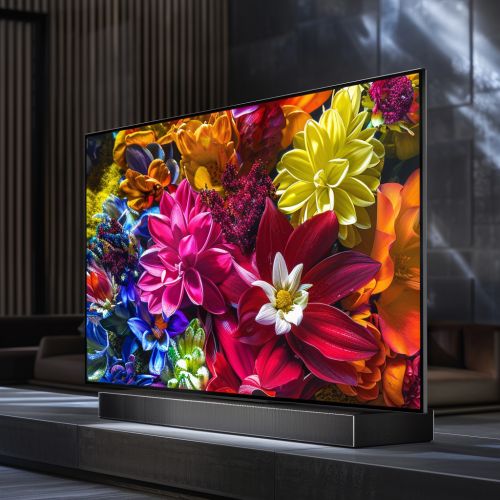QLED
Introduction
Quantum-dot Light Emitting Diode (QLED) technology represents a significant advancement in the realm of display technology. QLEDs are a type of light-emitting diode (LED) that utilize quantum dots to produce pure monochromatic red, green, and blue light. This article delves into the intricate details of QLED technology, exploring its development, working principles, advantages, and applications.
Development of QLED Technology
The development of QLED technology can be traced back to the early research on quantum dots in the 1980s. Quantum dots are semiconductor nanocrystals that possess unique optical and electronic properties due to their size and shape. The first practical application of quantum dots in display technology emerged in the early 2000s, leading to the development of QLEDs.
Early Research
Quantum dots were first discovered in the 1980s by Alexey Ekimov and Louis E. Brus. These nanocrystals exhibited size-dependent optical properties, which sparked interest in their potential applications in various fields, including display technology. The initial research focused on understanding the synthesis and properties of quantum dots.
Commercialization
The commercialization of QLED technology began in the early 2000s when companies like Samsung and Sony started investing in research and development. Samsung, in particular, played a pivotal role in advancing QLED technology, leading to the introduction of QLED TVs in the consumer market in the mid-2010s.
Working Principles of QLEDs
QLEDs operate based on the principles of quantum mechanics and semiconductor physics. The core component of a QLED is the quantum dot, which is a nanoscale semiconductor particle. These quantum dots are embedded in a film that is placed between the LED backlight and the display panel.
Quantum Dots
Quantum dots are typically made from materials such as cadmium selenide (CdSe), indium phosphide (InP), or zinc sulfide (ZnS). These materials are chosen for their ability to emit light at specific wavelengths when excited by an external energy source. The size of the quantum dot determines the color of the emitted light, with smaller dots emitting blue light and larger dots emitting red light.
Light Emission
When an electric current passes through the QLED, the quantum dots are excited and emit light. This light is then passed through color filters to produce the desired colors on the display. The use of quantum dots allows for precise control over the color and brightness of the emitted light, resulting in a high-quality display with vibrant colors and deep blacks.


Advantages of QLED Technology
QLED technology offers several advantages over traditional LED and OLED displays. These advantages make QLEDs a popular choice for high-end televisions and monitors.
Color Accuracy
One of the primary advantages of QLED technology is its superior color accuracy. Quantum dots can emit light at very specific wavelengths, resulting in highly accurate color reproduction. This makes QLED displays ideal for applications that require precise color representation, such as professional photo and video editing.
Brightness
QLED displays are capable of achieving higher brightness levels compared to OLED displays. This is because quantum dots can be driven at higher energy levels without degrading their performance. Higher brightness levels are particularly beneficial for viewing content in well-lit environments.
Longevity
QLEDs have a longer lifespan compared to OLEDs. This is because QLEDs do not suffer from burn-in, a phenomenon where static images can cause permanent damage to the display. The inorganic nature of quantum dots also contributes to their durability and longevity.
Applications of QLED Technology
QLED technology has found applications in various fields, ranging from consumer electronics to medical imaging.
Consumer Electronics
The most common application of QLED technology is in consumer electronics, particularly in televisions and monitors. QLED TVs offer superior picture quality, making them a popular choice among consumers. Additionally, QLED monitors are used by professionals who require high color accuracy and brightness.
Medical Imaging
QLED technology is also being explored for use in medical imaging. The high brightness and color accuracy of QLED displays make them suitable for applications such as diagnostic imaging and surgical displays. Researchers are investigating the potential of QLEDs to improve the accuracy and clarity of medical images.
Automotive Displays
The automotive industry is another area where QLED technology is being adopted. QLED displays are used in car dashboards and infotainment systems, providing drivers with clear and vibrant information. The durability and brightness of QLEDs make them well-suited for automotive applications.
Future Prospects of QLED Technology
The future of QLED technology looks promising, with ongoing research and development aimed at further improving its performance and expanding its applications.
Enhancements in Quantum Dot Materials
Researchers are continually working on developing new quantum dot materials that offer better performance and are more environmentally friendly. For example, there is a push to develop cadmium-free quantum dots to address environmental concerns associated with cadmium-based materials.
Integration with Other Technologies
QLED technology is also being integrated with other emerging technologies, such as MicroLED and MiniLED. These hybrid displays aim to combine the advantages of different display technologies to achieve even better performance.
Expansion into New Markets
As QLED technology continues to improve, it is expected to expand into new markets beyond consumer electronics. Potential applications include augmented reality (AR) and virtual reality (VR) displays, wearable devices, and advanced lighting solutions.
